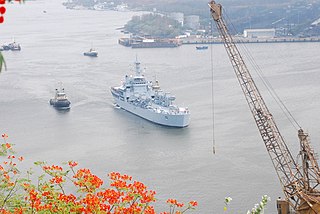
The Indian Navy is the naval branch of the Indian Armed Forces. The President of India is the Supreme Commander of the Indian Navy. The Chief of Naval Staff, a four-star admiral, commands the navy. As a blue-water navy, it operates significantly in Persian Gulf Region and the Horn of Africa to the Strait of Malacca, and routinely conducts anti-piracy operations and partners with other navies in the region. It also conducts routine two to three month-long deployments in the South and East China seas as well as the western Mediterranean sea simultaneously.

INS Vikramaditya is a modified Kiev-class aircraft carrier and the flagship of the Indian Navy, which entered into service in 2013.
The following ships of the Indian Navy have been named INS Shardul:
INS Shardul was a Kumbhir-class tank landing ship of the Indian Navy.

Shardul-class landing ships are large amphibious warfare vessels built at Garden Reach Shipbuilders and Engineers for the Indian Navy. They are an evolution of the Magar-class amphibious landing ships.
INS Kesari was a Kumbhir-class tank landing ship of the Indian Navy.

The Andaman and Nicobar Command (ANC) is the first and only tri-service theater command of the Indian Armed Forces, based at Port Blair in the Andaman and Nicobar Islands, a Union Territory of India. It was created in 2001 to safeguard India's strategic interests in Southeast Asia and the Strait of Malacca by increasing rapid deployment of military assets in the region. It provides logistical and administrative support to naval ships which are sent on deployment to East Asia and the Pacific Ocean.
The following ships of the Indian Navy have been named INS Kesari:
INS Sharabh was a Kumbhir-class tank landing ship of the Indian Navy
INS Ghorpad was a Kumbhir-class tank landing ship of the Indian Navy.

INS Cheetah is a Kumbhir-class tank landing ship of the Indian Navy.

INS Mahish is a Kumbhir-class landing ship of the Indian Navy.

INS Guldar is a Kumbhir-class landing ship of the Indian Navy.

INS Kumbhir is the lead vessel of her class of the amphibious warfare ships of the Indian Navy.

INS Bangaram (T65) the lead ship of the Bangaram class of the Indian Navy is designed for interdiction against fast moving surface vessels and for search-and-rescue operations in coastal areas and in the exclusive economic zone. Named after Bangaram in Lakshadweep, the vessel was designed and built by Garden Reach Shipbuilders and Engineers. The diesel generators on board are supplied by Cummins India. The electronic equipment on board is from Bharat Electronics Limited, ECIL and Hindustan Aeronautics Limited.

Mk III LCU class vessels were follow on class of Mk II LCU operated by the Indian Navy and were meant to augment the Indian Navy's amphibious capability. The ships were deployed for maritime roles like maritime security, beaching, un-beaching, humanitarian relief operations and evacuation from distant islands, search and rescue operations and peace-keeping missions. The landing craft were meant for use by amphibious forces to transport equipment and troops to the shore. They were capable of transporting tracked or wheeled vehicles and troops from amphibious assault ships to beachheads or piers. The landing craft were carried on board amphibious assault ships to the objective area. Built and delivered between 1986-87 the mission of the LCU was to land/retrieve personnel and equipment during amphibious operations. LCU's help land personnel and equipment after the initial assault waves of an amphibious operation.
INS Bitra (T66), the second ship of Bangaram-class patrol vessel of the Indian Navy, is designed for interdiction against fast moving surface vessels and for search-and-rescue operations in coastal areas and in the exclusive economic zone. Named after Bitra island in Lakshadweep, the vessel was designed and built by Garden Reach Shipbuilders and Engineers. The diesel generators on board are supplied by Cummins India. The electronic equipment on board including satellite communication and global positioning systems is from Bharat Electronics Limited, ECIL and Hindustan Aeronautics Limited. Rear Admiral Sanjay Vadgaokar commissioned the fast attack ship in Vasco da Gama, Goa on 28 March 2006.










